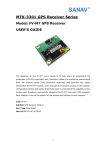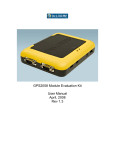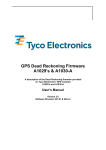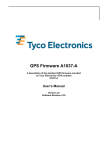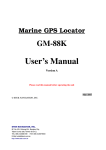Download DeLorme GPS2058 Specifications
Transcript
Two DeLorme Drive Yarmouth, ME 04096 (Phone) 800-293-2389 (Fax) 207-846-7054 www.delorme.com DELORME GPS2058-10 GPS Receiver Module Specification June 2008 General Description The DeLorme GPS2058 module combines the STMicroelectronics high sensitivity STA2058 (Teseo) GPS baseband chip with the STA5620 Low Power GPS RF front end to form a complete high performance GPS receiver module. The GPS2058 is an ideal solution for consumer, Handheld, PND (Portable Navigation), in-vehicle Navigation and Telematics systems. The GPS2058 is offered with a complete GPS firmware which performs all basic GPS operations including tracking, acquisition, navigation and data output with no need of external memories. SBAS (WAAS and EGNOS) features are also supported. Features • • • • • • • • • • Compact 16mm x 16mm footprint minimizes board space Very high sensitivity and fast time to fix for very accurate position fixes in all environments Fully Integrated RF Section for direct Interface to Active or Passive Antenna Systems GPS Firmware embedded in FLASH eliminates programming Standard NMEA0183 output message structure for easy interfacing Evaluation kit and Reference Design Available Low Power and standby modes for battery powered applications PPS Output Synchronized to UTC for Time Synchronization Applications Superior Multi-path Error rejection algorithm for optimum performance in urban canyons RoHS Compliant Performance Specifications 16-channel, L1 (1575.42 MHz) GPS receiver Reacquisition time Position Accuracy Acquisition Time • Hot Start • Warm Start • Cold Start Reacquisition Time Altitude Velocity 0.1 seconds average 2 meters, CEP 50% 2.5 seconds 34 seconds 39 seconds <1 second <+/35 m vertical in term of 95% 0.1 m/s Time (PPS) DGPS (Optional) Acquisition Sensitivity Tracking Sensitivity Velocity Acceleration Altitude Jerk +/-62ns Accuracy synchronized to UTC time <0.5m (depending on correction technique) -146dBm (warm) -159dBm <515 m/s (~1,000 knots) Max 4g Max <18,000 m (~60,000 ft) 20 m/s3 Functional Description The DeLorme GPS2058-10 module simplifies embedded applications of GPS-based information systems. The important components of a basic GPS receiver subsystem are LNA, SAW Filter, RF front end, power conditioning, and the GPS baseband receiver itself. All these subsystems have been built into the DeLorme GPS module to eliminate the cost and time needed for the user to develop them independently. In simple terms, the user must connect an active or passive antenna, provide a power source, and connect the module to a host system via a serial port (or USB) to produce GPS positional data and enable a complete GPS receiver system. Designed for PCB mounted application, the module has a tiny 16x16mm footprint for use in small form-factor end applications such as portable systems. For fast startup times, the Teseo baseband features an onboard 16KB of FLASH memory for storing the satellite almanac and ephemeris data, and this data is saved and restored automatically as a background process. This eliminates the need for additional external memory and eliminates any programming to save and recover this data. The Pulse-Per-Second (PPS) output provides an accurate timestamp, synchronized to Universal Coordinated Time (UTC). The time is established via communication with one satellite and verified with a second satellite. If a fix is obtained and lost the PPS will continue to run as long as the time is valid. No PPS pulse indicates the time is not valid. Page 1 Module Pinout Pin Descriptions Pin 1 2 3 4 5 6 7 8 9 10 11 12 13 14 15 16 17 18 19 20 21 22 23 24 25 26 27 28 29 30 31 32 33 34 35 36 37 38 39 40 Name Function Description Secondary Function Ground VCC nSTDBYO nSTDBYI WAKEUP nRESET AIN0 AIN1 AIN2 AIN3 VADC V18 n/c n/c n/c PPS GPIO0 GPIO1 GPIO2 GPIO3 GPIO4 GPIO5 USBDP USBDN JTCK JTMS JTDI JTDO nJTRST U0RX U0TX U1RX U1TX TRACKLED n/c n/c BOOTEN RFGND RF-IN RFGND Power Power Output Input Input Input I/O I/O I/O I/O Power Power I/O I/O I/O I/O I/O I/O I/O I/O I/O I/O I/O I/O Input Input Input Output Input I/O I/O I/O I/O I/O I/O I/O Input Ground Input Ground Digital Ground Digital 3.3v +/- 5% supply Low indicates Module is in standby mode Low input forces Module into standby mode Wakeup from standby mode Module reset active Low Analog Input 0 (Future) Analog Input 1(Future) Analog input 2 (Future) Analog Input 3 (Future) External ADC Power (tie to VCC if ADC's are not used) Optional 1.8V core supply to reduce power N/A N/A N/A Pulse Per Second Output GPIO0 GPIO1 GPIO2 GPIO3 GPIO4 GPIO5 USB Data Line Positive USB Data Line Negative JTAG Clock (Factory Test Only) JTAG Mode Select (Factory Test Only) JTAG Data Input (to module) (Factory Test Only) JTAG Data Output (from module) (Factory Test Only) JTAG Reset (active low) (Factory Test Only) NMEA UART0 Receive Data Input (to module) NMEA UART0 Transmit Data Output (from module) DEBUG UART1 Receive Data Input (to module) DEBUG UART1 Transmit Data Output (from module) 3D Fix Indicator N/A N/A Enable sampling of BOOT[0:1] pins on exit from external reset RF Ground, connect only to RF GPS signal in from antenna RF Ground, connect only to RF N/A N/A N/A N/A N/A N/A N/A N/A N/A N/A N/A N/A N/A N/A N/A N/A SPI0MISO (Future) SPI0MOSI (Future) 12C_CK (Future) 12C_D (Future) CANRX (Future) CANTX (Future) N/A N/A N/A N/A N/A N/A N/A N/A BOOT0 BOOTRX BOOTTX N/A N/A N/A N/A N/A N/A N/A Page 2 Block Diagram Typical Applications Page 3 Absolute Maximum Ratings Symbol Parameter Value Min Max VDD Voltage on VDD with respect to ground (VSS) -0.3 +4.0 V18 Voltage on optional 1.8V core supply input -0.3 +2.0 VADC Voltage on VADC pin with respect to ground (VSS) -0.3 +3.6 VIN Voltage on any pin with respect to ground (VSS) -0.3 +4.0 IOV Input Current on any pin during overload condition -10 +10 ITDV Absolute sum of all input currents during overload conditions |200| TST Storage Temperature -55 +150 ESD ESD Susceptibility (Human Body Model) 2000 Unit V V V V mA mA °C V NOTE: Stresses exceeding above listed recommended "Absolute Maximum Ratings" may cause permanent damage to the device. This is a stress rating only and functional operation of the device at these or any other conditions above those indicated in the operational sections of this specification is not implied. Exposure to absolute maximum rating conditions for extended periods may affect device reliability. Recommended Operating Conditions Symbol VDD VADC V18 TA TJ Parameter Min 3.0 VDD 1.7 -40 -40 Digital Supply Voltage for I/O Circuitry Analog Supply Voltage for the A/D Converter Voltage on optional 1.8V core supply input Ambient Temperature under bais Junction Temperature under bias Value Max 3.6 VDD 1.9 +85 +105 Unit V V V °C °C DC Electrical Characteristics Symbol VIH VIL VHYS VOH VOL RWPU RWPD Parameter Conditions Value Unit Min Typ Max Input High Level CMOS With or w/o Hysteresis 0.7*VDD V Input Low Level CMOS With or w/o Hysteresis 0.3*VDD V Input Hysteresis CMOS Schmitt Trigger 0.4 0.8 1.2 V Input Hysteresis Schmitt Trigger WAKEUP pin only 0.3 0.5 V Output High Level High Current Pins (GPIO) IOH = 8mA VDD - 0.8 V Output High Level Standard Current Pins IOH = 4mA VDD - 0.8 V Output Low Level High Current Pins (GPIO) IOL = 8mA 0.4 V Output Low Level Standard Current Pins IOL = 4mA 0.4 V Weak Pull-up Resistor Measured at 0.5 VDD 100 KΩ Weak Pull-down Resistor Measured at 0.5 VDD 100 KΩ AC Electrical Characteristics Symbol IDDRUN IDDRUN18 IDDSB1 IDDRESET0 Parameter RUN mode current Run mode current using both 3.3V 1.8V supplies (internal regulator powered off) STANDBY mode current RESET mode current Conditions Min VDD=3.3V, 33MHz 3.3V supply current 1.8V supply current LP Vreg and 32kHz OSC on Active but held in Reset Value Typ Max 85 35 50 Unit 90 8 uA mA mA mA mA Environmental Specifications Operating Temperature -40 °C to +85 °C Storage Temperature -55 °C to +100 °C Relative Humidity 5% to 95%, non-condensing Page 4 Mechanical Diagram GPS2058 RECOMMENDED PC BOARD LAYOUT UNITS MM & [ IN ] .450 11.43 .050 1.27 .068 1.73 .040 1.02 .652 16.56 .020 R0.51 .652 16.56 GPS2058 PACKAGE OUTLINE 14.83±0.05 3.07±0.05 PIN 1 INDICATOR 0.79±0.03 FR4 THICKNESS 40 x R0.33 SOLDERING CASTELATIONS 1.27±0.05 16±0.05 16±0.05 UNITS: MM Page 5 Ordering Information Ordering Code: GM-205810-000 Tape And Reel minimum order quantity: 500 units Tape Dimensions Page 6 Minimum Application Connectivity The following describes the minimum GPS2058 GPS receiver module connectivity necessary to obtain a position fix with passive antenna and host connection. The Antenna connects to the module on the RF-input pin. It is very important that this connection maintains a 50 ohm impedance with minimal discontinuities to maximize the energy transfer from the antenna to the module RF input. Both RF ground pins (38 and 40) must be isolated from digital ground through a 100nH inductor to eliminate high frequency loop currents and preventing self jamming from digital noise injected into the RF section or RF noise from being introduced to the digital section. Refer to our application note titled ‘GPS Module Antenna and RF Design Guidelines’ for additional discussion and layout recommendations. Power is supplied to the module by connecting a 3.3V digital supply to pin 2. Use 0.1uF decoupling cap as close to the module pin as possible. Pin 1 is digital ground, connect to ground plane as close to module as possible. For reducing the supply current when an additional 1.8V supply is available, refer to the section titled “Power Supply Options” in this document. To ensure that module powers up in the correct state, nRESET (pin 6) must be tied to 3.3V thru a 10Kohm resistor to prevent accidental receiver reset. The WAKEUP input (pin 5) must be tied to 3.3V thru a 10Kohm resistor and the nSTDBYI input (pin 4) must also be tied to 3.3V thru a 10K ohm resistor to hold the receiver out of standby mode. A 0.1uF cap to ground is also tied to the nSTDBYI input to delay the ramp up to 3.3V, which brings the pin biasing up in the right sequence. The UART0 NMEA connection is a CMOS level TTL signal level. Pin 31 is the transmit output pin for sending the NMEA data FROM the module TO the host, and pin 30 is the receive input for sending commands FROM the host TO the Module. The VADC input (pin 11) should also be tied to the 3.3V supply to properly bias the device. A decoupling capacitor of 0.1uF is used as close to the pin as possible. All other pins may remain unconnected. Page 7 Power Supply Options The GPS2058 module can be powered by two different methods. The preferred method will depend on the supply voltages available on the PCB and the power consumption goals of the system. A single external 3.3V supply can be used to power the entire module. When only the external 3.3V supply is used the voltage is down converted inside the module to supply the core 1.8V. Using an external 3.3V supply requires 85mA (typical) of total current for the entire module. There is power loss associated with the internal regulator. If external 3.3V and 1.8V sources are both available to power the module the internal regulator can be shut off to eliminate its power loss. The external 3.3V supply is still needed to power the I/O and some other components in the module requiring 3.3V (i.e.; LNA). When using the dual 3.3V and 1.8V supply rails approximately 50mA of current comes from the 1.8V rail while about 35mA will come from the 3.3V supply. There is a NMEA command to turn off the internal regulator, $PDME,12,2. When the GPS2058 is initially powered on (and not in STANDBY mode) the $PDME,12,2 command can be issued to power off the internal regulator and reduce the total power consumption. When a hardware reset occurs the 1.8V regulator is powered on and the $PDME,12,2 command must be reissued to bypass the 1.8V regulator. Note that the GPS2058 will still function properly using two supplies with the internal regulator still ON, providing the V18 never exceeds 2.0V (abs max). When an external 1.8V supply is not used the V18 supply pin should be left floating. In order to fully enter STANDBY mode you should disable the internal 1.8V regulator when using an external 1.8V supply. Coming out of STANDBY mode will require you to re-issue the command to disable the internal regulator if an external 1.8V supply is used. Page 8 STANDBY MODE In Standby mode, the CPU core is switched off to reduce power consumption. The Real Time Clock and Wake-Up logic remains independently powered by an internal low-power voltage regulator for fast start-ups coming out of Standby mode. The Standby mode power-down sequence may be initiated by either a software command, or by hardware control using the nSTDBYI and WAKEUP inputs. DO NOT tie the nSTDBYI and WAKEUP pins together if you are using STANDBY mode. Coming out of Standby mode requires the nSTDBYI and WAKEUP inputs to be in the proper state even if Standby mode was initiated via software (see below). The WAKEUP input must be low to initiate Standby mode. If WAKEUP is high then Standby mode cannot be initiated by any event, software or hardware. A Reset event (nRESET pin goes low) has priority over nSTDBYI. Therefore, reset activation will force an exit from the Standby mode. If nRESET is activated while nSTDBYI is logic high, the device exits from Standby mode. If a Reset pulse is given while nSTDBYI is kept at constant low level, the device will enter Standby mode again after nRESET rising edge. The nSTDBYO output is useful as an indication of the module status – when this output is low the module is in Standby mode. Software STANDBY The following figure shows the sequence of events when entering Standby mode via software by sending a $PDME,13,1,#seconds command to the GPS2058. When this command is executed the module will enter Standby mode if the WAKEUP input is low. After the #seconds has timed out the module wakes itself up and the CPU restarts. If the #seconds is zero the module remains in standby mode indefinitely, or until an external wake-up is initiated via the WAKEUP input or a reset event occurs. Applying a positive pulse of 100us (minimum) on the WAKEUP pin switches the main internal voltage regulator back on and applies power to the core. The CPU core is kept in reset mode until the internal voltage is correctly regulated, then the CPU restarts itself. If the nSTDBYI pin is low when the device wakes up, the module will re-enter Standby mode. Page 9 Hardware STANDBY To enter Standby mode via hardware requires bringing the nSTDBYI pin to a logic low state while the WAKEUP input is low. If the WAKEUP pin is at a high logic level the GPS2058 will not enter Standby mode. To exit standby mode via hardware both the WAKEUP and nSTDBYI pin must be high. The WAKEUP rising edge switches the Main Voltage Regulator back on, while nSTDBYI pin rising edge releases the internal Reset to the CPU core. Page 10 NMEA Output Messages When the GPS receiver is running a set of messages is presented on the NMEA port. These output strings are compatible with the NMEA 0183 standard and provide all the information needed by a navigation system. At system run-time the current message list can be modified using the $PDME,11 (see the NMEA software commands section). A description of the available (NMEA 0183) navigation messages is reported in the next pages. $GPGGA GPS fix data, message available at startup in the default message list. It can be enabled/disabled with the $PDME,11 command. GGA5 (default) provides latitude/longitude out to 5 decimal places. GGA provides latitude/longitude out to 2 decimal places. Message rate: 1 Hz Message: $GPGGA,<PosUTC>,<Lat>,<LatRef>,<Lon>,<LonRef>,<Qual>,<NbSat>,<HDOP>,<AltMsl>,M,<GeoidSep>,M,<null>, <null>*checksum<cr><lf> Field Description Format PosUTC Universal time coordinated Hhmmss.sss Lat Latitude ddmm.mmmmm LatRef Latitude direction 'N' or 'S' Lon Longitude dddmm.mmmmm LonRef Longitude Direction 'E' or 'W' Qual Quality indicator X 0 – no fix 1 – GPS fix 2 – Differential GPS fix NbSat Number of satellites in use Xx HDOP Horizontal dilution of precision x.x AltMsl Antenna altitude above/below main sea level x.x M Meters 'M' GeoidSep Geoidal separation x.x 'M' M Meters Null – Null – $GPGSA DOP and active satellite list, available at startup in the default message list. It can be enabled/disabled with the $PDME,11 command. Message rate: 1 Hz Message: $GPGSA,<Opmode>,<FixMode>,<Sat>,<Sat>,<Sat>,<Sat>,<Sat>,<Sat>,<Sat>,<Sat>,<Sat>,<Sat>,<Sat>,<Sat>,< PDOP>,<HDOP>,<VDOP>*checksum<cr><lf> Field Description Format Opmode Operating mode (A for automatic switch 2D/3D) 'A' Fixmode Fis mode X 1 – no fix 2 – 2D fix 3 – 3D fix Sat ID of the satellite Xx / null PDOP Position dilution of precision (PDOP) in meters x.x HDOP Horizontal dilution of precision (HDOP) in meters x.x VDOP Vertical dilution of precision (VDOP) in meters x.x Page 11 $GPGSV Satellites in view, available as soon as the first satellite is acquired. It can be enabled/disabled with the $PDME,11 command. Note that this message is repeated MaxMsg times to report the status of all satellites in view (up to 16 satellites). Message rate: 1 Hz Message: $GPGSV,<MaxMsg>,<NumMsg>,<NumSats>,<SatPrn>,<Elev>,<Az>,<SNR>,<SatPrn>,<Elev>,<Az>,<SNR>, <SatPrn>,<Elev>,<Az>,<SNR>,<SatPrn>,<Elev>,<Az>,<SNR>*checksum<cr><lf> Field Description Format MaxMsg Total number of messages X NumMsg Message number X NumSats Total number of satellites in view Xx SatPrn Satellite PRN number Xx Elev Elevation in degrees (90 maximum) Xx Az Azimuth in true degrees (000 to 359) Xxx SNR SNR (C/No) 00 to 99dB, null when tracking Xx $GPVTG Track made good and ground speed. It can be enabled/disabled with the $PDME,11 command. Message rate: 1 Hz Message: $GPVTG,<TrueCourse>,T, <MagneticCourse>,M,<SpeedKnots>,N,<SpeedKmh>,K*checksum<cr><lf> Field Description Course (True) Measured reading (True) T True Course (Magnetic) Measured heading (magnetic) M Magnetic Speed Knots Measured horizontal speed (knots) N Knots SpeedKmh Measured horizontal speed (km/h) K Kilometers per hour Format $GPRMC Recommended minimum specific data. Available at startup in the basic message list. It can be enabled/disabled with the $PDME,11 command. Message rate: 1 Hz Message: $GPRMC,<PosUTC>,<PosStat>,<Lat>,<LatRef>,<Lon>,<LonRef>,<Spd>,<Hdg>,<Date>,<MagVar>,<MagRef> *checksum<cr><lf> Field Description Format PosUTC Universal time coordinated Hhmmss.sss PosStat Position status (A=valid or V=invalid) 'A' or 'V' Lat Latitude Ddmm.mmm LatRef Latitude direction 'N' or 'S' Lon Longitude Dddmm.mmm LonRef Longitude Direction 'E' or 'W' Spd Speed over ground (knots) x.x Hdg Heading track make good (degree true) x.x Date Date Ddmmyy MagVar Magnetic variation (degree) (Future) Future MagRef Magnetic variation (Future) Future Page 12 $GPGLL Geographic Position - Latitude/Longitude. It can be enabled/disabled with the $PDME,11 command. Message rate: 1 Hz Message: $GPGLL,<Lat>,<LatRef>,<Lon>,<LonRef>,<PosUTC>,<Status>*checksum<cr><lf> Field Description Format Lat Latitude Ddmm.mmm LatRef Latitude direction 'N' or 'S' Lon Longitude Dddmm.mmm LonRef Longitude Direction 'E' or 'W' PosUTC Universal time coordinated Hhmmss.sss Status Status A – Data valid, V – Data invalid 'A' or 'V' NMEA Software Commands Summary of Commands $PDME,0.....................................................Cold Start $PDME,1.....................................................Warm Start $PDME,2.....................................................Hot Start $PDME,4,n..................................................Version information $PDME,5.....................................................Get threshold DOPs $PDME,6,n,f1,f2,f3......................................Set threshold DOPs $PDME,7.....................................................Get sat. masking angle $PDME,8,f...................................................Set sat. masking angle $PDME,9,n1,n2,n3,n4,n5,n6,n7,n8,n9..........Init GPS position & time $PDME,10,n................................................NMEA Port Msg control $PDME,11,n1,h,n2......................................NMEA Message config $PDME,12,n................................................System control set A $PDME,13,n1,n2.........................................System control set B Page 13 Command: Cold Start Format: $PDME,0<cr><If> Variables: None Return: If monitoring NMEA, the module will issue power-on start-up message (Delorme F/W and H/W versions are displayed), satellite vehicle NMEA message should indicate only 1 satellite (i.e., $GPGSV,1,1…) and the active satellite message will indicate no fix ($GPGSA,A,1…). Operation: Suspends GPS operations, clears ephemeris and almanac, invalidates user position and RTC, then issues restart/reset Application: Diagnostic purposes – used to reproduce TTFF for an initial acquisition. Command: Warm Start Format: $PDME,1<cr><If> Variables: None Return: If monitoring NMEA, the module will issue power-on start-up message (Delorme F/W and H/W versions are displayed), satellite vehicle NMEA message will maintain existing information but the active satellite message will indicate no fix ($GPGSA,A,1…). Operation: Suspends GPS operations, clears ephemeris then issues restart/reset Application: Diagnostic purposes – used to reproduce TTFF for a device that had a previous fix and is downloading new ephemeris info. Command: Hot Start Format: $PDME,2<cr><If> Variables: None Return: If monitoring NMEA, the module will issue power-on start-up message (Delorme F/W and H/W versions are displayed), satellite vehicle NMEA message will maintain existing information but the active satellite message will indicate no fix ($GPGSA,A,1…). Operation: Suspends GPS operations, then issues restart/reset Application: Diagnostic purposes – used to reproduce TTFF for a device that had a previous fix and is downloading new ephemeris info. Command: Get Version Information Format: $PDME,4,n<cr><If> Variables: n = 1, 2, 3 or 4 Return: If n=1, return is “$PDME,4,1, GPS2058_FW_1.0.0”; if n=2, return is “$PDME,4,2, GPS2058_HW_1.0.1”; if n=3, return is “$PDME,4,3, GPS_LIBRARY_VERSION GPSLIB_5.4.1.5 GNU – Jun 11 2007 10:05:32”; if n=4, return is “$PDME,4,4, WAAS_VERSION SBASLIB_01.08.03 – Jun 11 2007 10:05:42”. Operation: n=1 returns DeLorme firmware revision, n=2 returns DeLorme hardware revision, n=3 returns GPS library revision, n=4 returns SBAS/WAAS library revision Application: Informational; n=1 and n=2 are valuable for revision checking by systems integrators Command: Get Dilution of Precision Threshold Values Format: $PDME,5<cr><If> Variables: None Return: “$PDME,5,<pdop3>,<hdop3>,<vdop3>,<pdop2>,<hdop2>,<vdop2>” Operation: Returns the threshold values used for determining a fix; by default these are very large values. 3-D thresholds are sent first, followed by 2D. Application: Informational; used in conjunction with the Set DOP to restrict or loosen initial position calculation thresholds Command: Set Dilution of Precision Threshold Values Format: $PDME,6,n,f1,f2,f3<cr><If> Variables: n=3 for 3D DOP thresholds, n=2 for 2D DOP thresholds, f1=positional DOP, f2=horizontal DOP, f3=vertical DOP Return: “$PDME,6,OK” if the command is accepted Operation: Sets the thresholds used for initial positional accuracy calculations in either 3D or 2D fix types. Application: Used for restricting or loosening initial position calculations. Threshold DOPs may range from 1 (ideal) to 50 (poor), but tend to be set to large values, e.g., 30. Operational DOPs, which are different than the threshold DOPs, typically range from 1-2 (ideal to excellent) Page 14 Command: Get Satellite Masking Angle Format: $PDME,7<cr><If> Variables: None Return: “$PDME,7,<maskang>” Operation: Returns the angle below which satellites are ignored; returned value is in whole degrees for the current GPS Library. Application: Informational; used with Set Mask Angle to establish and effective satellite horizon to eliminate multipath (reflected) signals Command: Set Satellite Masking Angle Format: $PDME,8,f<cr><If> Variables: f=0 to 90 degrees Return: “$PDME,8,OK” if the command is accepted Operation: Sets the angle below which satellites are ignored; decimal values may be entered but the GPS Library only accepts whole numbers as of now. Application: Valuable tool for eliminating multipath signals typically found in environments with a limited sky view and a lot of reflected satellite signals, such as urban canyons. Command: Initialize GPS Position and Time Format: $PDME,9,n1,n2,n3,n4,n5,n6,n7,n8,n9<cr><If> Variables: n1=Latitude in (whole) degrees n2=Longitude in (whole) degrees n3=Altitude in (whole) meters n4=Year (four digits) n5=Month (1-12) n6=Day(1-31) n7=Hour(0-23) n8=Min(0-59) n9=Sec(0-59) Return: “$PDME,9,OK” if the command is accepted Operation: Sets the values used for the initial position calculations Application: Valuable for a unit that has been moved while off; a faster TTFF can be achieved by preloading the position and time information; must be issued immediately after a reset or startup to be most effective. Command: NMEA Port Messaging Controls Format: $PDME,10,n<cr><If> Variables: n = 0,1, 2, 3,4 or 5 Return: “$PDME,10,OK” if command is accepted. Operation: n=0,1 turns NMEA messages Off or On, respectively; n=2,3 turns ECH messages Off or On, respectively, but if the NMEA messages are off, the n=2,3 has no effect. n=3,4 turns Debug messages Off or On, respectively. When on, Debug info is directed to the NMEA port and regular NMEA messages are disabled; Debug information remains on the Debug port. Disabling the Debug message returns the NMEA port to normal messaging. Application: Valuable for customizing the content selection on NMEA port. Page 15 Command: NMEA Messaging Configuration Format: $PDME,11,n1,h,n2<cr><If> Variables: All variables are independent of each other. n1= Baud Rate, acceptable values 4800 (default) 9600 19200 38400 57600 115200 h = Hex value to enable the corresponding NMEA message 0x01 = GGA 0x02 = GGA5 (default; see note below) 0x04 = GSA (default) 0x08 = GSV (default) 0x10 = VTG 0x20 = GLL 0x40 = RMC (default) 0x80 = RF 0x40000 = RF Test, diagnostic n2 = 0 (broadcast on UTC second, default) 1 (broadcast after fix) Return: “$PDME,11,OK” if the command is accepted Operation: Configures the communications parameters for the NMEA port (only). Application: Used for customizing the NMEA messages and changing communications rates. (All serial communications uses <Baud Rate>,8,N,1.) Care should be taken when using higher rates so as to avoid overloading the stream. For example, the GSV messaging will broadcast three lines of ASCII when a full contingent of satellites is available, so lower rates are recommended for GSV. The default message selection is given by 0x40+0x08+0x04+0x02 = 0x4E, so an equivalent default statement is “$PDME,11,4800,0x4E,0”. Note: GGA5 is equivalent to GGA except that there are 5 decimal places of precision in the location values. Command: System Control Set A, Bypass Internal 1.8V Regulator Format: $PDME,12,n<cr><If> Variables: n = 2 Return: “$PDME,12,OK” if the command is accepted Operation: Assumes an external 1.8V source is connected to pin 12 of the module. This command bypasses the internal regulator in favor of the external connection. The bypass is cleared through a hardware reset. Application: The primary purpose is to save on power. The internal regulator takes 3.3V as its source and the core of the device operates at 1.8V wasting significant power. Command: System Control Set A, Invalidate RTC Format: $PDME,12,n<cr><If> Variables: n = 3 Return: “$PDME,12,OK” if the command is accepted Operation: This can be used to invalidate the RTC information obtained from the first satellite. Application: Diagnostic command; this is a key component in a Cold Start but rarely used alone. It is most effective in the early stages of establishing a fix because once communications from multiple satellites has been established the module will assume its RTC is valid. Command: System Control Set A, Install SBAS Satellite List Format: $PDME,12,n<cr><If> Variables: n = 4 Return: “$PDME,12,OK” if the command is accepted Operation: This is an internal command that moves the SBAS list into the WAAS/SBAS operational code. Application: This is usually handled automatically but may be of value if WAAS communications is problematic. Page 16 Command: System Control Set A, Return Estimated Position Error Format: $PDME,12,n<cr><If> Variables: n = 5 Return: “$PDME,12,<horizontal error>,<vertical error>” Operation: Returns a running statistical estimate of horizontal and vertical positional errors in meters. Application: Useful for general evaluation of accuracy, particularly if a more elaborate data collection tool is not available to collect and analyze the data in more detail. Command: System Control Set A, GPS Leap Seconds Format: $PDME,12,n<cr><If> Variables: n = 6 Return: “$PDME,12,<leap second value>” Operation: Returns the number of leap seconds added to UTC relative to maintain consistency with mean solar time (and GPS timing). Application: Valuable information for UTC synchronized GPS systems. Command: System Control Set B, Software Standby Mode Format: $PDME,13,n1,n2<cr><If> Variables: n1 = 1, n2 = any integer Return: “$PDME,13,OK” if the command is accepted Operation: This is used to put the module into standby mode; if n2=0, the module enters standby mode indefinitely and requires an external wakeup (pin 5 high) or reset (pin 6 low) to remove the standby; any other value of n2 is equivalent to the number of seconds the module remains in standby Application: This is valuable for power savings. The module drops to less than 100uA during standby, so it may be self timed off the RTC crystal or left in standby indefinitely until woken up by hardware. Command: System Control Set B, WAAS Control Format: $PDME,13,n1,n2<cr><If> Variables: n1 = 2, n2 = 0 or 1 Return: “$PDME,13,OK” if the command is accepted Operation: If n2 = 0, WAAS can be disabled; if n2 = 1 (default), WAAS is (re)enabled; Application: In most cases, leaving WAAS enabled provides the better fix. If WAAS is disabled, the vacated processing channel can be used to capture information from another GPS satellite. Command: System Control Set B, Set SBAS Satellite PRN Code Format: $PDME,13,n1,n2<cr><If> Variables: n1 = 3, n2 = valid SBAS PRN codes Return: “$PDME,13,OK” if the command is accepted Operation: This is used to select a specific WAAS satellite by PRN code. As of this writing, valid WAAS PRNs are 122, 134, 135 and 138 (East Coast). Valid EGNOS satellites are 120, 124 and 126. Valid MSAS satellites are 129 and 137. Application: This can be used to improve the fix time for WAAS (by eliminating the need for hunting) or to improve a fix if the module is located on the boundary where two SBAS satellites are available and one is obscured. Command: System Control Set B, Set RF Test Satellite PRN Code Format: $PDME,13,n1,n2<cr><If> Variables: n1 = 3, n2 = 0 – 11 (GPS correlator channel number) Return: “$PDME,13,OK” if the command is accepted Operation: This is used to select a specific satellite for the RF Test (NMEA) Message (see section on “NMEA Messaging Configuration”) Application: This is a diagnostic which will return the PRN, center frequency, phase error and CN0 (gain) of the satellite in that GPS correlator channel. Page 17 Recommended Reflow Profile The following graph shows a suggested reflow profile for an automated surface mount assembly processes. This reflow profile follows the recommendations for the lead-free solder used in the module assembly. The reflow process follows 4 complete stages: Pre-heat: Ramp to 130°C at a rate of 2°C/second Soak: Ramp from 130 to 165°C over 60-150 seconds Reflow: Ramp from 165°C to 217°C at a rate of 2°C/second. The peak reflow temperature should be 230-250°C, total time above 217°C should be less than 45 seconds Cool-down: A cooling rate of 3°C/second is recommended Ideally the module will only be subjected to a single reflow process with the module on the top side surface of the printed circuit board. Additional reflows may cause bridging between pads, or potential damage to the module. If the PCB is a two-sided board the secondary reflow should be performed with the module on the top side of the board to avoid damage to the module. If a secondary reflow is performed with the module on the bottom side of the printed circuit board the weight of the shield can or entire module may exceed the adhesive properties of the solder menisci and the shield can or the entire module may fall off the board. Page 18


















